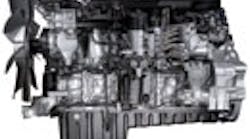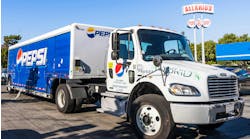LOUISVILLE, KY. After announcing its subsidiary Detroit Diesel will deploy selective catalytic reduction (SCR) aftertreatment—which uses urea—to meet EPA 2010 emissions rules, Daimler Trucks North America (DTNA) sought this morning to dispel what it regards as misinformation about SCR that it believes is confusing North American fleet owners.
“We will be utilizing Daimler’s BlueTec technology for our Detroit Diesel engines beginning in 2010,” said Chris Patterson, president & CEO of DTNA (which produces Freightliner, Sterling and Western Star trucks), speaking at a media briefing before the opening of the Mid-America Trucking Show today. “The technology…is the only means of meeting the stringent 0.2 g/kWh NOx standard for heavy-duty diesel engines in 2010 while actually reducing diesel fuel consumption in comparison with the technology used in 2007 engines.”
“Given U.S. driving conditions characterized by steady cruising speeds on the highways and enormous overland distances, the new BlueTec system will show its advantages early on,” said Mike Delaney, DTNA senior vp of marketing. “The BlueTec system with SCR technology is projected to increase fuel efficiency by about 3 to 5%--significant fuel savings in a typical North American truck fleet.” He also said that the urea used by the SCR system should require refilling only about every 5,000 to 6,000 miles per 20-gal. tank under typical highway duty cycles.
But beyond saying the European-born technology was headed here, Delaney declared DTNA is committed to “dispelling the SCR misinformation being tossed about—and to talk about what we know works and is in fact working today in trucks worldwide.” He noted that automotive-grade urea—also known as diesel exhaust fluid (DEF) or, in Europe, AdBlue—is non-toxic, not harmful to the environment and poses no real hazards when used properly.
Delaney said the operating range for the urea used by the SCR system should require refilling only about every 5,000 to 6,000 miles per 20-gal. tank under typical highway duty cycles. He stated that in Europe—where more than 500,000 heavy-duty trucks with SCR are on the road—freezing of urea “has not been a problem” because urea won’t freeze until 12 degrees and the urea thaws very quickly from the warmth of the engine, tank and supply system. “The trucks are running with no issues today in Finland and even in the Arctic Circle.” And according to Delaney, based on customer feedback and Daimler warranty and quality control input, maintenance issues related to SCR are minimal.
He went on to address what is arguably the biggest concern many fleets have about urea—availability. “One of the primary arguments against SCR from EGR engine developers [those not planning to use SCR] is that finding DEF on the road could be difficult,” said Delaney.
“The DEF manufacturers, the distributors that supply liquids to thousands of truckstops and dealerships today, the packaging companies that do this in their sleep, and the truckstops that absolutely understand how to dispense fluid to truckers, all say this is pretty vanilla,” declared Delaney. “The preparation for 2010 is in full swing and they are all working quietly together to bring this to fruition here by 2010.”
He pointed out that DTNA alone has over 850 locations where DEF will be available. “Add the truck dealers, diesel distributors, and service points of the other OEMs committed to SCR, and there will be over 1700 points of supply going in,” he stated. “With a range of 5,000 to 6,000 miles—or nearly twice the width of the whole country—one would have to work pretty hard to run out of DEF.
“The toughest remaining issue about SCR is not the technology and it is not the infrastructure,” added Delaney. “The only real issue remaining, and the toughest ground to cover, will be education.”
Among other announcements made at the briefing, DTNA said it has added a second sleeper model—the 72-in. XT-- to its Cascadia on-highway truck lineup. This truck is designed specifically for flatbed and tanker operations and features a “full height” standup sleeper that measures 78 in. from the base of the bunk to the ceiling.



